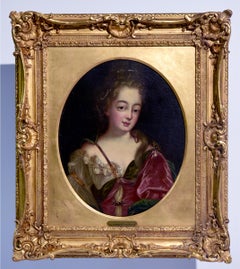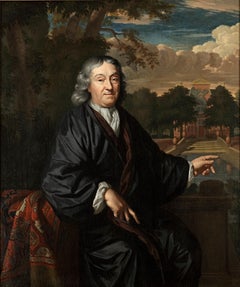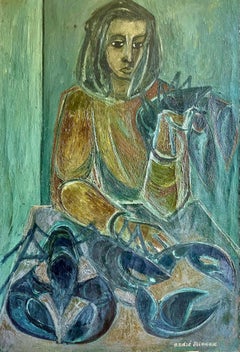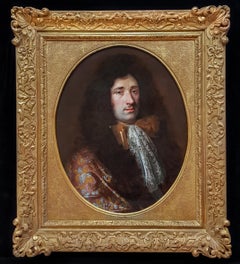(circle of) Nicolas de Largillierre Paintings
French, 1656-1746
Nicolas de Largillière or de Largillierre (Paris, 10 October 1656 - Paris, 20 March 1746) was a French painter.
Raised in Antwerp, where his family had moved in 1659, it was in the Flemish city that he began his apprenticeship in the workshop of Antoine Goubeau starting in 1668, mainly influenced by Rubens and the Flemish masters. [He entered the guild of the Sint-Lucasgilde as master of the city in 1674.
From 1675 to 1679 he traveled to England, where he approached the Vandyckian painter Peter Lely and was noticed by King Charles II. He will return there in 1685 to paint a portrait of the new King James II.
Returning to France, after 1689 he became one of the most sought-after painters, both for official ex-votos or allegories, and for orders of portraits by the nobility and the upper middle class. Nicolas de Largillière was, together with Rigaud, the portrait painter of the Regency era. He also proved to be a brilliant painter of still lifes, following the Flemish school.
To the solemnity of the gesture of the person portrayed he combined an uncommon search for minute details.
In 1686 he was admitted to the Académie royale de peinture et de sculpture, becoming a professor in 1705 and directing it from 1736 to his resignation in 1743.
Among his most important works we can mention: Portrait of Elizabeth Beaubarnais (Museum of Grenoble); Young Man as Diana (Louvre Museum); Ex-voto in Sainte-Geneviève (church of Saint-Étienne-du-Mont, Paris); Family portrait of Louis XIV (Wallace Collection); Portrait with the family (Louvre Museum).to
1
Overall Width
to
Overall Height
to
1
1
1
1
1
1
1
1
1
1
1
1
781
717
705
691
1
1
Artist: (circle of) Nicolas de Largillierre
"Mme de Noirmont", Oil on Canvas Portrait, circa 18th Century
By (circle of) Nicolas de Largillierre
Located in Detroit, MI
This painting titled "Mme de Noirmont" is an oil on canvas work from the studio of Nicolas de Largilliere, one of the most prolific and esteemed French portrait painters of the 18th ...
Category
18th Century (circle of) Nicolas de Largillierre Paintings
Materials
Canvas, Adhesive, Oil
Related Items
Male and female portrait, both in silk kimono, possibly textile dealers
By Christoffel Lubieniecki
Located in Amsterdam, NL
CHRISTOFFEL LUBIENIECKI (1659-1729)
Pair of portraits of a gentleman and a lady, both in silk kimono, before a country house (circa 1680)
Indistinctly signed “C.......” on a box under the man’s left hand
Oil on canvas, 79.5 x 67 cm each
Both sitters are portrayed wearing a silk “Japanese” coat. During the second half of the seventeenth the Japanese silk coat, an adapted Japanese kimono, became a real vogue in the Dutch elite. The exclusive Dutch trade contacts with Japan can explain the popularity of the kimono-style silk coats in the Netherlands. Everybody who could afford one, dressed in such a fashionable and comfortable coat and, like the present sitters, some proud owners had themselves portrayed in a “Japanese” coat often together with an oriental carpet to underline their standing and international connections. These portraits are the work of the Polish-born portraitist Christoffel Lubieniecki (also known as Lubienitski, Lubinitski or Lubiniecki)
Lubieniecki was first trained in Hamburg under Julian Stuhr and after 1675 in Amsterdam under Adriaen Backer and Gerard de Lairesse. He specialized in landscapes, generally of an Italianate character, and in portraits. The loving execution of these contented burghers, enjoying the garden vistas of their country house, places him alongside Amsterdam portraitists such as Constantijn Netscher and Michiel van Musscher...
Category
1680s Old Masters (circle of) Nicolas de Largillierre Paintings
Materials
Canvas, Oil
$37,662
H 31.34 in W 26.38 in D 1.97 in
"Femme et Homards" (Woman with Lobsters), 1948 -André Minaux (French, 1923-1986)
By Andre Minaux
Located in Berlin, MD
Behold a mid-century marvel by André Minaux, a titan of the French School whose stylized Social Realist visions continue to captivate the art world. Painted in 1948, “Femme et Homard...
Category
Mid-20th Century French School (circle of) Nicolas de Largillierre Paintings
Materials
Cotton Canvas, Oil
$5,135
H 62.25 in W 43.5 in D 3 in
Venice Landscape Italian Oil on Canvas Painting in Gilt Wood Frame, Belle Epoque
Located in Firenze, IT
This delightful turn of the century (early 20th century) oil on canvas painting represents an Italian landscape with one of the most famous squares in the world: Piazza San Marco in ...
Category
Early 20th Century Impressionist (circle of) Nicolas de Largillierre Paintings
Materials
Canvas, Oil
Venice Landscape Italian Oil on Canvas Painting in Gilt Wood Frame, Belle Epoque, Early 20th Century
$8,385 Sale Price
25% Off
H 51.19 in W 33.47 in D 1.19 in
“Enfant A La Collarette” The Child in the Collar.
By René Genis
Located in Berlin, MD
Rene Genis (French 1922-2004) “Enfant A La Collarette” The Child in the Collart. Portrait of a disturbing young man with a rather defiant, petulant look in his expression. Dark eye...
Category
Mid-20th Century (circle of) Nicolas de Largillierre Paintings
Materials
Canvas, Oil, Laid Paper
$2,025 Sale Price
48% Off
H 24 in W 16 in D 1 in
Holy family under an oak tree on a gold background
Located in BELEYMAS, FR
French school circa 1870
Holy Family under an oak, after Raphaël, on gold background
Oil on canvas
H. 92 cm; W. 60 cm
This aesthetic curiosity takes up the very famous composition b...
Category
19th Century French School (circle of) Nicolas de Largillierre Paintings
Materials
Canvas, Oil
Oil on Canvas Painting Portrait of the Italian Noble Family of Zanardi Count
By Lucia Casalini Torelli
Located in Firenze, IT
This museum quality old master oil on canvas formal portrait painting depicting the family of the Count Zanardi is signed by the artist- the female painter Lucia Casalini Torelli- and published in a book dedicated to Casalini Torelli’s workshop and academy.
This palatial masterpiece artwork comes directly from the ancient Villa Maraini Guerrieri - Palidano di Gonzaga (Mantua), an historic Italian heritage building owned by the descendants of the family portrayed for more than two centuries, until 1998.
The big scale of this oil on canvas masterpiece painting states the relevance of Lucia Casalini Torelli as a painter. The present artwork is a formal family portrait painting that aim to introduce the characters depicted according to their social role in the society. The noble family is all gathered under a loggia overlooking a park, the landscape in the background is partially covered by a beautiful red cloth on the right side.
The father stands up and holds the hand of his eldest son, proudly introducing his future heir. The son wears a light-blue dress and red boots, he is depicted in a serious pose holding a black tricorn hat under his arm and a rapier sword on his belt.
The mother wears an elegant gold and dark green brocade dress, she is sitting with her youngest daughter on her knees while her second son is by her side. The little daughter wears a lovely long red and dress with white lace and holds an apple on her hand. The son stands next to his mother and is dressed in a brown priestly clothes.
This palatial old masters piece was probably painted in 1740 due to the similarities with Cardinal Doria’ s portrait, now on display at the Doria Palace Museum, the official residence of the Prince of Genoa.
The painting features original canvas (“prima tela”) and antique original patina, it is in excellent overall condition considering the age, use and its large scale. A formal detailed condition report and the results of the inspection with the UV lamp accompanied by photos is available on request.
As well as for its exceptional quality and quite perfect state of conservation, this painting is particularly important and even more valuable both for the artist who painted it and for its absolutely exclusive provenance.
Lucia painted the most prominent and powerful noble families of her time, the location of these paintings is unknown to the art market as it is extremely likely that the portraits are still kept in private collections.
Furthermore, Lucia was one of the most appreciated artists of her time, so important that she was admitted as a member of the academy at a time when women were forbidden to attend these studies.
In 1706, Felice Torelli...
Category
18th Century Old Masters (circle of) Nicolas de Largillierre Paintings
Materials
Canvas, Oil
$170,659
H 94.49 in W 85.44 in D 1.19 in
Self-portrait in Indonesian Landscape
Located in Amsterdam, NL
Abraham Johannes Romswinckel (1810-1856)
Self-portrait in Indonesian landscape
Inscribed Abr. Joh. Romswinckel, geb. Batavia 17 Oct. 1810, overl...
Category
1820s Romantic (circle of) Nicolas de Largillierre Paintings
Materials
Canvas, Oil
$9,415
H 27.37 in W 22.96 in D 1.97 in
Portrait of a Geisha
By Roland Strasser
Located in Amsterdam, NL
Roland Strasser (1895-1974)
"Japanese Geisha"
Signed lower right
Oil and gold leaf on canvas, measures: 76 x 46 cm
In fine white-wash wood frame.
...
Category
1930s Expressionist (circle of) Nicolas de Largillierre Paintings
Materials
Gold Leaf
A Chinese Company playing Droughts
Located in Amsterdam, NL
ERWIN BINDEWALD (1897-1950)
Two men playing draughts, a girl with the red book standing behind them
Signed and dated E. Bindewald d.j., 27
Oil on canvas, 140.5 x 90.5 cm
In black and gilt gesso frame.
Note:
Bindewald was born in Charlottenburg. He moved to Berlin in 1914 where he studied till 1924 at the Berliner Kunst Akademie. Bindewald travelled in Europe, but mainly stayed in Germany and certainly never was in China. This painting was made in Europe, presumably in the China Town of Berlin. Bindewald received several commisions in Germany from factory owners who wanted their factories painted inside, usually with workers, as well as outside. In the present painting the sitter on the right seems to be a man with a Manchurian background, wearing the brown coat reserved for the highest aristocracy in China.
In China the black sleeve-ends completely cover the hands, indicating that the high aristocracy does not have to do any manuel labour. This man clearly is not a factory worker but he possibly is the (co)- owner of the factory in the background and as such might need his hands to do at least some writing. The man on the left in the modern Western suit...
Category
1920s Art Deco (circle of) Nicolas de Largillierre Paintings
Materials
Canvas, Oil
Presumed artist self-portrait
Located in BELEYMAS, FR
Louis-Gabriel BLANCHET
(Versailles, 1701 – Rome, 1772)
Presumed self-portrait of the artist
Oil on canvas
H. 73 cm; W. 60 cm
Circa 1730
Originally presented in a Restoration period frame with a "Mignard" cartouche, this beautiful painting initially appeared to us as a work from northern Italy. However, it exuded a rather French form of refinement, suggesting that its artist may have assimilated a dual influence from both sides of the Alps.
We thank our colleague and friend Philippe Mendès for spontaneously and judiciously "bringing out" the name of Louis-Gabriel Blanchet, a Romanized French portraitist, whose spirit and stylistic characteristics we clearly recognize here.
Blanchet's "French" years, before his final departure for Rome in 1728, following his winning of the second Grand Prix for painting after Subleyras in 1727, are extremely poorly documented. His father, Gabriel, was valet to Blouin, himself Louis XIV's first valet at the time. According to Thierry Lefrançois, Blanchet was one of the few students of Nicolas Bertin (1667-1736), whose studio he is said to have joined in the early 1720s. At a baptism on March 24, 1724, where he was godfather, he is mentioned as a painter in the picture store of the Duke of Antin, the director of buildings between 1708 and 1736. At this time, he was probably already married to Jeanne Quément, with whom he had a daughter also named Jeanne, who would marry Nicolas Aviet, the son of a valet in the queen's wardrobe, in Versailles in 1738.
When Blanchet arrived in Rome in October 1728, he was accompanied by Subleyras, Trémolières, and Slodtz. He enjoyed the goodwill of Vleughels, the director of the Académie de France, which had been based at the Palazzo Mancini since 1725, even though the latter was not always kind to our resident. From 1732, he was under the protection of the Duke of Saint-Aignan when he took up his post as ambassador to Rome. Along with Slodtz and Subleyras, they formed a trio of friends, joined by Joseph Vernet shortly after his arrival in Rome in 1734. Slodtz and Blanchet, on the occasion of Subleyras's marriage in 1739, were there to attest that their friend was not bound by any marital commitment, and Blanchet was a witness at Vernet's wedding in 1745.
It is most likely from these early years in Rome that our portrait of the artist dates, the expression and turn of his face irresistibly reminiscent of a self-portrait. The still relatively youthful features may correspond to Blanchet's thirty-something years, and the fluffy wig was still fashionable at this time.
The painting fits well with the depiction of a young painter wanting to display both the beginnings of success and a certain simplicity or restraint. A slight smile expresses a form of assurance in this man with a gentle, sincere gaze and a face radiating a keen sense of wit. We find here the air of intimacy present in almost all of Blanchet's portraits, even those from the 1750s and 1760s, as well as an almost complicity with the viewer. The spirit of the painting is quite close to that of the presumed portrait of Bouchardon (painted around 1730) and the portrait of Pannini, painted in 1736, but it possesses a more natural quality, notably thanks to the absence of decorum. Our work exhibits the characteristics of Blanchet's paintings: elegance, luminosity (especially in the whites), vibrant and refined colors (here, the harmony of the garnet of the garment and the slate blue of the background, whose uniformity is tempered by a very sketched landscape and a grove of greenery), light complexions, rather rosy cheekbones, often full lips, and rather tight framing.
According to the Academy's rules, Blanchet's stay should have ended in the spring of 1732, but, for reasons unknown, he remained in the Eternal City until his death, as did his friend Subleyras, with whom he shared accommodation until the late 1730s. The latter regularly called upon him to collaborate on his paintings, such as The Meal at Simon's. Through Saint-Aignan's intervention, Blanchet was employed in the late 1730s by the Stuart princely family, then exiled in Italy. He notably produced copies (now lost) after Liotard of the portraits of Charles Edward and Henry Benedict, the sons of James III Stuart. The latter also commissioned three other portraits (now in the National Portrait Gallery in London), whose more formal character contrasts with the intimate spirit of Blanchet's portraits. Blanchet frequented English painters, such as the landscape painter Richard Wilson, and studied with the Scottish portraitist Katherine Read...
Category
1730s French School (circle of) Nicolas de Largillierre Paintings
Materials
Oil, Canvas
Salome and the Head of Saint John the Baptist
Located in BELEYMAS, FR
Italian School, late 17th century
Salome and the Head of Saint John the Baptist
Oil on canvas
H. 109 cm; W. 83 cm
The theme of Salome receiving the head of Saint John the Baptist is ...
Category
1680s Italian School (circle of) Nicolas de Largillierre Paintings
Materials
Oil, Canvas
Presumed portrait of Marie-Anne de Bourbon
By Nicolas de Largillière
Located in BELEYMAS, FR
Nicolas de LARGILLIERRE
(Paris 1656 – 1746)
Portrait of a woman, presumed to be Marie-Anne de Bourbon, Princess of Conti (1666-1739)
Oil on oval canvas
H. 8...
Category
Early 1700s French School (circle of) Nicolas de Largillierre Paintings
Materials
Canvas, Oil
$47,078
H 31.5 in W 24.02 in
Previously Available Items
17th Century French Portrait of a Gentleman; Fine Frame
By (circle of) Nicolas de Largillierre
Located in London, GB
This item has a long and interesting provenance. This work formed part of a collection of pictures from the antiquaire André Coltée Ducarel (1713-1785). It descended through the Coltée Ducarel family the Palmer Baronets for over 300 years.
This half-length portrait depicts a gentleman believed to be an ancestor of André Coltée Ducarel (1713-1785). The sitter is wearing a Japanese rok which was a type of banyan of rich brocaded silk, a crisp white lace cravat and silk bows. These garments were at the height of fashion in 1680's France. The banyan was commonly worn indoors (sometimes called an Indian or Persian gown due to their Eastern origin and Oriental cut) when visitors were met. Although very comfortable they were highly respectable and quite splendid (often made from brocades, velvets and silks, with elegant masses of fabric protecting against the cold or draughts). These garments and the full bottomed wig would have cost a fortune.
The popularity of wigs was immense and this intensified the demand for them so much that natural hair became a valued commodity. Dealers in hair arose in all quarters and there are accounts in France that every peasant girl was trying to sell her hair. Unfortunately wig theft became common.
The delicate modelling of the face and the sophisticated handling of the garments, notably the cravat, is indicative of a talented artist who excelled at the oil technique of painting. Presented in a good quality gilded antique frame.
Provenance: The portrait has descended through the Coltée Ducarel family and Palmer Baronets for over 300 years:-
• André (Andrew) Coltée Ducarel (1713-1785), Doctor of Civil Law in 1742, English antiquary, archivist, and librarian at Lambeth Palace, m. Sarah Desborough (1696-1791) and then to:
• the son of his deceased youngest brother Gérard Gustavus Coltée du Carel (1745-1800), Marquis du Carel, Governor of Bengal m. daughter of the Maharajah of Purnea, and then to their son:
• Philip John Ducarel (1778-1855) of Newland, Gloucestershire m. Catherine Jane Hyde Shawe (1786-1802) and then to:
• his sister Mary's niece Elizabeth Julian Fench Simpson m. Charles Archdale Palmer (1813-1860), and then to their son:
• Sir Frederick Archdale Palmer, 6th Baronet Palmer (1857-1933), and then to their son:
• Sir John Archdale Palmer, 7th Baronet Palmer (1894-1963), and then to their son:
• Sir John Edward Somerset Palmer, 8th Baronet Palmer (1926-)
André (Andrew) Coltée Ducarel was born in Paris. His parents, Jacques Coltée Ducarel (1680-1718) and Jeanne Crommelin (1690-1723), were Huguenots from Normandy. Jacques was a banker and merchant, who achieved ennoblement in 1713 with the title Marquis de Chateau de Muids. He died in 1718, just as a new wave of Huguenot persecution was beginning, and in 1719 Jeanne fled with her three infant sons to England where they settled in Greenwich. There, Jeanne married her second husband, Jacques Girardot, another Huguenot. Andrew was sent to be educated at Eton and he later matriculated at Oxford from Trinity College, and graduated as a Bachelor of Civil Law. He was created Doctor of Civil Law in 1742 before being admitted a member of the College of Advocates at Doctors' Commons in 1743, and afterwards served as librarian there 1754-7, and as treasurer 1757-61. Ducarel was a fellow of the Society of Antiquaries of London, and he was one of the first fellows of the society on its incorporation in 1755. He was a fellow of the Royal Society of London. He was keeper of Lambeth Palace Library; a post that he remained in for nearly 30 years. He published a number of his own works. For many years Ducarel went on an antiquarian tour through different parts of the country, attended by a coachman and footman. They travelled about fifteen miles a day, and put up at inns. After dinner, Ducarel transcribed his topographical and archaeological notes. In 1752, he undertook a tour of Normandy and through his publications he effectively put Normandy on the map for the late 18th-century English traveller. He was one of the first Englishmen to see and appreciate the significance of the Bayeux Tapestry, and included the first detailed description in English as an appendix to Anglo-Norman Antiquities.
The work later passed to Sir Frederick Archdale Palmer, 6th Baronet Palmer (1857-1933). This branch of the Palmer Baronetcy, family seat Wanlip Hall in the County of Leicester, was created in 1791 for Charles Grave Hudson, a Director of the South Sea Company and High Sheriff of Leicestershire in 1784. Today, the heir apparent is Robert John Hudson...
Category
17th Century Old Masters (circle of) Nicolas de Largillierre Paintings
Materials
Canvas, Oil
(circle Of) Nicolas De Largillierre paintings for sale on 1stDibs.
Find a wide variety of authentic (circle of) Nicolas de Largillierre paintings available for sale on 1stDibs. You can also browse by medium to find art by (circle of) Nicolas de Largillierre in canvas, fabric, oil paint and more. Much of the original work by this artist or collective was created during the 18th century and earlier and is mostly associated with the Old Masters style. Not every interior allows for large (circle of) Nicolas de Largillierre paintings, so small editions measuring 22 inches across are available. Customers who are interested in this artist might also find the work of Sir Godfrey Kneller, Studio of Sir Peter Lely, and Giulio Di Sotto. (circle of) Nicolas de Largillierre paintings prices can differ depending upon medium, time period and other attributes. On 1stDibs, the price for these items starts at $2,582 and tops out at $12,000, while the average work can sell for $7,291.



